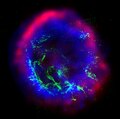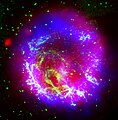File:E0102-72 3- In Perspective (2000-0015multi - e0102).tiff
From Wikimedia Commons, the free media repository
Jump to navigation
Jump to search

Size of this JPG preview of this TIF file: 591 × 599 pixels. Other resolutions: 237 × 240 pixels | 473 × 480 pixels | 757 × 768 pixels | 1,200 × 1,217 pixels.
Original file (1,200 × 1,217 pixels, file size: 8.81 MB, MIME type: image/tiff)
File information
Structured data
Captions
Captions
Color composite of the supernova remnant E0102-72: X-ray (blue), optical (green), and radio (red). E0102-72 is the remnant of a star that exploded in a nearby galaxy known as the Small Magellanic Cloud.
Summary
[edit]| DescriptionE0102-72 3- In Perspective (2000-0015multi - e0102).tiff |
English: Color composite of the supernova remnant E0102-72: X-ray (blue), optical (green), and radio (red). E0102-72 is the remnant of a star that exploded in a nearby galaxy known as the Small Magellanic Cloud. The galaxy is approximately 190,000 light years from Earth, so we see the remnant as it was about 190,000 years ago, around a thousand years after the explosion occurred. The star exploded outward at speeds in excess of 20 million kilometers per hr (12 million mph) and collided with surrounding gas. This collision produced two shock waves, or cosmic sonic booms one traveling outward, and the other rebounding back into the material ejected by the explosion. The radio image was made using the Australia Telescope Compact Array. The radio waves are due to extremely high-energy electrons spiraling around magnetic field lines in the gas and trace the outward moving shock wave. The Chandra X-ray image, shown in blue, shows gas that has been heated to millions of degrees Celsius by the rebounding, or reverse shock wave. The X-ray data show that this gas is rich in oxygen and neon. These elements were created by nuclear reactions inside the star and hurled into space by the supernova. The Hubble Space Telescope optical image shows dense clumps of oxygen gas that have "cooled" to about 30,000 degree Celsius. Images such as these, taken with different types of telescopes, give astronomers a much more complete picture of supernova explosions. They can map how the elements necessary for life are dispersed, and measure the energy of the matter as it expands into the galaxy. Chandra X-ray Observatory Advanced CCD Imaging Spectrometer Image (ACIS) Reference: T. J. Gaetz et al. 2000, "Chandra X-ray Observatory Arsecond Imaging of the Young Oxygen-Rich Supernova Remnant 1E0102.2-7219", Astrophysical Journal Letters, 534, L47. |
| Date | 10 April 2000 (upload date) |
| Source | E0102-72.3: In Perspective |
| Author | X-ray: NASA/CXC/SAO, Optical: NASA/HST, Radio: CSIRO/ATNF/ATCA |
| Other versions |
|
| Also Known As InfoField | SN010102-72 |
| Category InfoField | Supernovas & Supernova Remnants |
| Color Code InfoField | Different colors for each wavelength |
| Constellation InfoField | Tucana |
| Coordinates (J2000) InfoField | RA 01h 04m 02.40s |
| Distance Estimate InfoField | 200,000 light years |
| Scale InfoField | Image is 1 arcmin across. |
| Instruments InfoField | ACIS |
 |
This media is a product of the Chandra X-ray Observatory Credit and attribution belongs to the Chandra X-ray Center, NASA/SAO/Penn State University/MIT |
Licensing
[edit]| Public domainPublic domainfalsefalse |
| This file is in the public domain in the United States because it was solely created by NASA. NASA copyright policy states that "NASA material is not protected by copyright unless noted". (See Template:PD-USGov, NASA copyright policy page or JPL Image Use Policy.) |  | |
 |
Warnings:
|
File history
Click on a date/time to view the file as it appeared at that time.
| Date/Time | Thumbnail | Dimensions | User | Comment | |
|---|---|---|---|---|---|
| current | 21:49, 14 June 2024 |  | 1,200 × 1,217 (8.81 MB) | OptimusPrimeBot (talk | contribs) | #Spacemedia - Upload of https://chandra.si.edu/photo/2000/0015multi/e0102.tif via Commons:Spacemedia |
You cannot overwrite this file.
File usage on Commons
The following 4 pages use this file:
Metadata
This file contains additional information such as Exif metadata which may have been added by the digital camera, scanner, or software program used to create or digitize it. If the file has been modified from its original state, some details such as the timestamp may not fully reflect those of the original file. The timestamp is only as accurate as the clock in the camera, and it may be completely wrong.
| Image title | The Chandra X-ray image (blue) shows gas that has been heated to millions of degrees Celsius by a shock wave moving into matter ejected by the supernova. This gas is rich in oxygen and neon. The radio image (red) made with the Australia Telescope Compact Array, traces the outward motion of a shock wave due to the motion of extremely high-energy electrons. The optical image (green) made with the Hubble Space Telescope, shows dense clumps of oxygen gas that have "cooled" to about 30,000 degree Celsius. |
|---|---|
| Author | Chandra X-ray Observatory Center |
| Width | 1,200 px |
| Height | 1,217 px |
| Bits per component |
|
| Compression scheme | LZW |
| Pixel composition | RGB |
| Orientation | Normal |
| Number of components | 3 |
| Number of rows per strip | 36 |
| Horizontal resolution | 150 dpi |
| Vertical resolution | 150 dpi |
| Data arrangement | chunky format |
| Software used | Adobe Photoshop CS2 Macintosh |
| File change date and time | 16:48, 28 June 2006 |
| Exif version | 2.21 |
| Color space | Uncalibrated |



